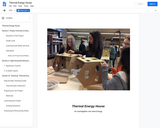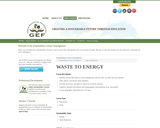
This short video introduces the alternative energy sources of solar panel.
- Subject:
- Agricultural Education
- Career Technical Education
- Material Type:
- Lesson
- Provider:
- National Geographic
- Author:
- National Geographic Society
- Date Added:
- 02/26/2019

This short video introduces the alternative energy sources of solar panel.

Resources include active webpages with text about major topics associated with climate change issues and a music video for the song "Take Aim at Climate Change." The lyrics in the rap music video provide background content information about the causes and effects of global climate change. A supplemental page links footnoted information in the lyrics to additional web resources.

In this engineering unit, students are developing background knowledge on heat, heat transfer and conservation. While this unit can be a stand-alone exercise, it has been designed to provide a way for students to gather data and derive evidence-based conclusions to help them choose the best materials to use in a science class solar cooker project. Students build cardboard houses to explore the movement and conservation of heat energy. A heat source is placed inside the house and students use vernier temperature probes and graphing software to gather and tabulate temperature data. Each house is standard, so that the students understand that we are all gathering data in a consistent way.
Students must calculate percentage of wall space given to doors and windows. Students will compare data from team to team, examining heat loss as recorded by temperature differences as a function of window and door areas. Students will cover doors and windows with various materials, examining different insulating qualities. Students will examine the effect on temperature of different colors of wall surface on the interior of the house. After gathering data, students will work to draw conclusions from the gathering of data. Students will construct charts and tables to tabulate data by hand, then will transfer data to Excel spreadsheets if technology is available.

Students will participate in a hands-on simulation that will enable students to take on the roles of hydropower managers by manipulating and reacting to three essential variables: precipitation and runoff, power production needs, and spillage.

Students examine where our power comes from, how the resource mix has changed over the years and how it might change in the future. They will examine the costs and benefits of using different sources of energy to generate electricity and rate the sources.

Students will explore how energy demands can be satisfied through waste-to-energy plants. They will examine data related to the use of incineration to produce energy.

Students explore the advantages and disadvantages of different energy sources for generating electricity. A particular focus is given to natural gas extracted from shale formations through the hydraulic fracturing process. At the end of the module, students will be able to compare the relative costs and benefits (abundance, ecological impacts, etc.) of different sources used for generating electricity.

This video discusses fossil fuels - what they are and why they are a problem for the environment. A set of discussion questions and post-viewing activities are provided.

In this unit, students review the difference between forms and sources of energy and learn about the environmental, economic and social trade offs of electrical energy generation.

This encyclopedia entry is for the term "tide." The regular rise and fall of the ocean?s waters are known as tides. Along coasts, the water slowly rises up over the shore and then slowly falls back again. Text for this entry is appropriate for the middle and high school grade levels.